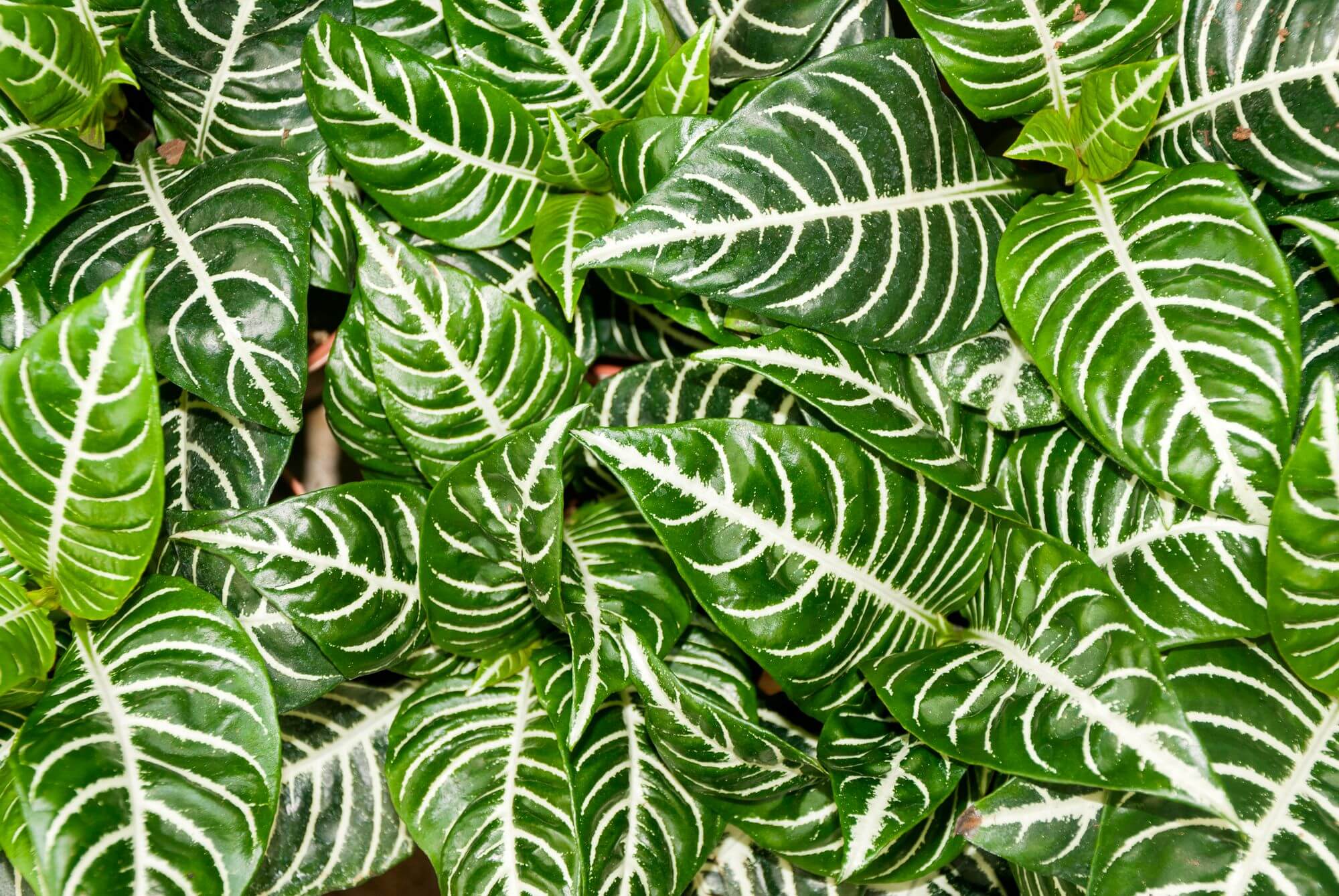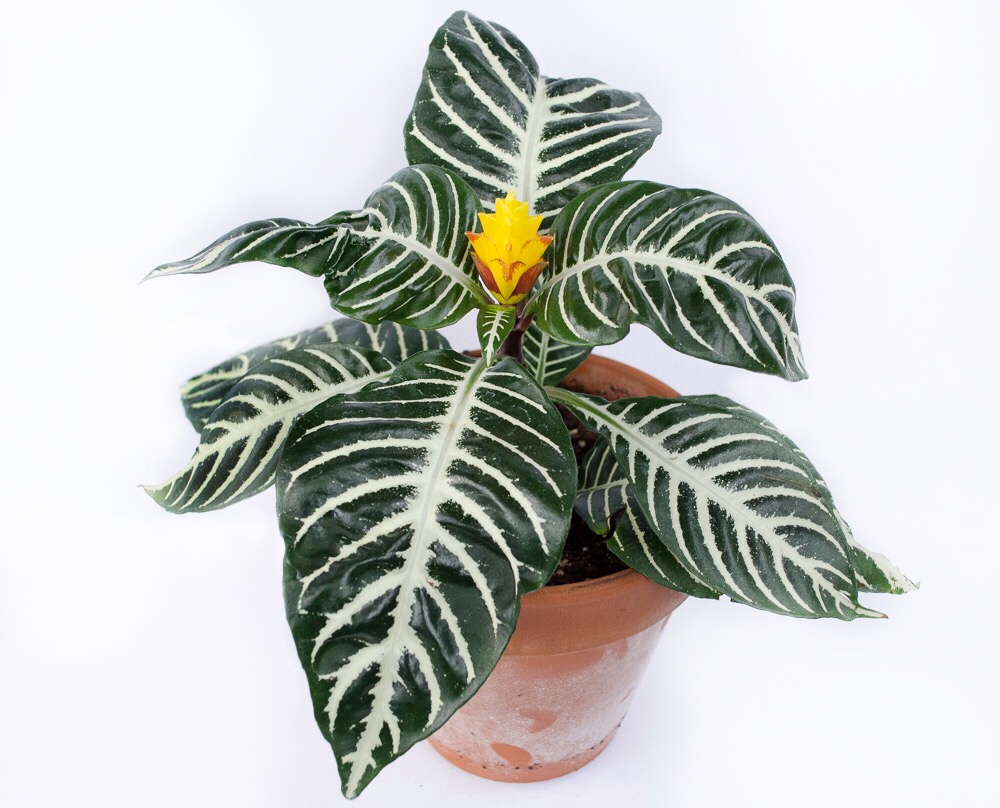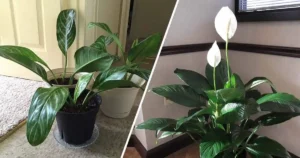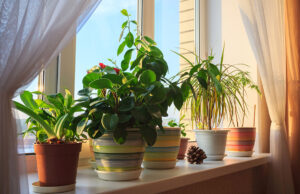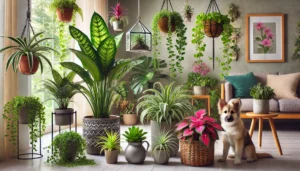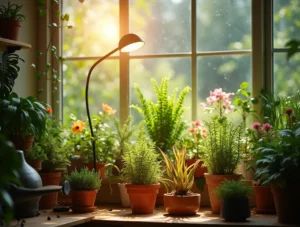Zebra plants, scientifically known as Aphelandra squarrosa, are beloved for their striking foliage and vibrant yellow flowers. With their distinctive striped leaves, they add a touch of the exotic to any indoor space. However, while their beauty is undeniable, these tropical plants require specific care to thrive. In this guide, we’ll dive deep into everything you need to know about growing and caring for Zebra plants, ensuring that your plant stays healthy and vibrant for years to come.
On This Page
What is a zebra plant?
Zebra Plants, native to the lush rainforests of Brazil, are part of the Acanthaceae family. They’re named for their unique foliage—broad, dark green leaves with bold, white stripes that resemble a zebra’s coat. These plants are primarily grown for their decorative leaves, but they also produce stunning, bright yellow flowers in the right conditions.
Key Characteristics:
- Scientific Name: Aphelandra squarrosa
- Origin: Brazil’s tropical rainforests
- Appearance: Large, glossy green leaves with white veins and striking yellow bracts that can last several weeks
- Size: Typically grows to about 1-2 feet in height indoors
Why Zebra Plants Are Popular: Zebra Plants are cherished for their ornamental value. Their dramatic foliage adds a pop of color and pattern to indoor spaces, making them a favorite among houseplant enthusiasts. Additionally, their ability to thrive in low-light conditions makes them versatile for various home environments.
Fun Fact: The Zebra Plant is not just a decorative plant. In Brazil, it’s also valued for its use in traditional medicine, though this aspect is less known outside its native region.
For more information about the plant family and related species, you can explore the Royal Horticultural Society website.
Different Types of Zebra Plants
While Aphelandra squarrosa is the most recognized species under the name “Zebra Plant,” there are several varieties and related species that plant enthusiasts might find intriguing. Each variety offers its own unique characteristics, making them appealing for different reasons. Understanding these differences can help you choose the right Zebra Plant for your home and ensure that you provide the care it needs.
Common Varieties of Zebra Plants
Aphelandra squarrosa ‘Louisae’
- Description: This variety is known for its slightly smaller leaves compared to the standard Aphelandra squarrosa. The leaf pattern is less pronounced, with softer white veining, making it a subtler option for those who prefer a more understated look.
- Care Requirements: Like the standard Zebra Plant, ‘Louisae’ thrives in bright, indirect light and high humidity. It’s somewhat less demanding, making it a good choice for beginners.
Aphelandra squarrosa ‘Dania‘
- Key Characteristics: ‘Dania’ is characterized by its broad, bright green leaves with bold, white stripes that are more prominent than those on other varieties. This variety is also known to flower more frequently when given the right conditions.
- Care Tips: This variety prefers slightly warmer temperatures and needs consistent moisture to thrive. Regular misting and careful attention to watering can help maintain its vibrant appearance.
Aphelandra squarrosa, ‘Red Aphelandra’
- Unique Features: While not as common as other varieties, the ‘Red Aphelandra’ is a visually striking plant with a hint of red or burgundy in its leaves, especially under the right light conditions. This variety is particularly popular in regions where more vibrant indoor plants are in demand.
- Care Recommendations: This variety requires the same care as other Zebra Plants but may need slightly more light to maintain its colorful leaf variegation. Ensuring the plant has ample humidity is also crucial.
Selecting the Right Variety for Your Home
When choosing a zebra plant, consider the aesthetic you’re aiming for as well as your ability to meet the plant’s care needs. ‘Dania’ and ‘Red Aphelandra’ varieties are excellent choices if you’re looking for a plant that offers visual drama. In contrast, ‘Louisae’ may be ideal if you prefer something a bit more understated and easier to care for.
Tip: To see how different varieties look in a real home setting, check out this houseplant enthusiast’s blog for more images and detailed care tips.
How to Grow Zebra Plants
Growing Zebra Plants can be a rewarding experience, but it requires attention to detail and an understanding of their natural habitat. In their native tropical environments, Zebra Plants enjoy warm temperatures, high humidity, and filtered sunlight. Replicating these conditions indoors is key to helping your plant thrive.
Best Growing Conditions for Zebra Plants
1. Light Requirements:
Zebra plants thrive in bright, indirect light. They’re accustomed to the dappled sunlight of the rainforest canopy, so placing them near an east or north-facing window where they receive gentle morning light is ideal. Avoid direct sunlight, which can scorch their delicate leaves, leading to unsightly brown patches. If your home doesn’t have sufficient natural light, you can supplement with fluorescent grow lights, keeping them about 12 inches above the plant.
2. Temperature and humidity:
Zebra Plants prefer a consistent temperature range between 65 and 80 °F (18 and 27 °C). They are sensitive to cold drafts and sudden temperature changes, which can cause leaf drop. Maintaining a stable environment is crucial, especially during winter months. Additionally, these plants thrive in high humidity
levels—ideally between 60 and 70%. To boost humidity:
- Place the plant on a pebble tray filled with water.
- Regularly mist the leaves with room-temperature water.
- Use a humidifier in the room where the plant is located.
3. Soil Requirements:
Zebra Plants need well-draining soil to prevent root rot, a common issue if the plant sits in waterlogged soil. A peat-based potting mix is ideal, as it retains moisture without becoming too soggy. You can create an effective mix by combining:
- Two parts peat moss
- One part perlite or coarse sand
- One part potting soil
The ideal soil pH is slightly acidic to neutral (pH 5.5–6.5). You can check your soil’s pH using a soil testing kit, available at most garden centers or online.
How to Plant Zebra Plants
1. Choosing the Right Pot:
Selecting a pot with adequate drainage is essential to prevent water from pooling at the bottom, which can lead to root rot. A pot with drainage holes at the base is necessary. The size of the pot should be just slightly larger than the plant’s root ball—about 1-2 inches wider. Zebra Plants prefer being slightly root-bound, so avoid pots that are too large.
2. Soil Preparation:
Before planting, ensure the soil is properly prepared. If using a store-bought potting mix, consider adding extra perlite to enhance drainage. Sterilize the soil by baking it at 180°F (82°C) for 30 minutes if you’re reusing soil from another plant. This step helps eliminate any pests or pathogens that might harm your zebra plant.
3. Planting Process:
- Step 1: Fill the bottom of your chosen pot with a layer of pebbles or small stones to further improve drainage.
- Step 2: Add a layer of your prepared soil mix, filling the pot about one-third full.
- Step 3: Place the Zebra Plant in the pot, ensuring the root ball is centered and at the correct depth. The top of the root ball should be about an inch below the pot’s rim.
- Step 4: Fill in around the root ball with the remaining soil mix, gently pressing down to eliminate air pockets.
- Step 5: Water the plant thoroughly until water drains out of the bottom, then allow it to settle before placing it in its new location.
Tip: After planting, avoid moving the zebra plant too often. These plants prefer a stable environment and can react poorly to frequent changes in light or temperature.
Zebra Plant Care Tips
Zebra Plants are known for their dramatic foliage and vibrant yellow flowers, but keeping them in top condition requires a dedicated care routine. Proper watering, fertilizing, pruning, and repotting are all essential to maintaining a healthy Zebra Plant. Below, we’ll cover detailed care tips to ensure your plant thrives.
Watering Zebra Plants
1. How Often to Water: Zebra Plants need consistent moisture, but they are sensitive to overwatering, which can lead to root rot. The key is to keep the soil evenly moist without allowing it to become waterlogged. Water your Zebra Plant when the top inch of soil feels dry to the touch. This typically means watering every 5–7 days during the growing season (spring and summer) and less frequently during the dormant period (fall and winter).
2. Watering Technique: When watering, use room-temperature, filtered water or let tap water sit out overnight to allow any chlorine to dissipate. Water the plant thoroughly, allowing water to flow through the drainage holes. Discard any excess water from the saucer to prevent the roots from sitting in water. If your plant’s leaves start to droop or turn yellow, it’s a sign you may need to adjust your watering routine.
Fertilizing Zebra Plants
1. Best Fertilizers:
Zebra plants benefit from regular feeding during their active growth period. Use a balanced, water-soluble fertilizer with a ratio like 20-20-20 or one slightly higher in phosphorus, which supports flowering (e.g., 10-20-10). Liquid fertilizers are ideal because they are easy to apply and quickly absorbed.
2. Fertilizing Schedule:
- Spring and Summer: Feed your Zebra Plant every 2-4 weeks during these months. Dilute the fertilizer to half the recommended strength to avoid over-fertilization, which can lead to salt buildup in the soil and cause leaf burn.
- Fall and Winter: Reduce feeding to once every 6–8 weeks or stop altogether as the plant’s growth slows down.
Tip: Always water your plant before applying fertilizer to prevent root burn. Leach the soil by thoroughly watering it every few months to flush out any excess salts from fertilizers.
Pruning and Maintenance
1. When and How to Prune:
Pruning helps keep your Zebra plant compact and encourages bushier growth. The best time to prune is in early spring, before the growing season begins. Use sharp, sterile pruning shears to trim back any leggy or overgrown stems. Also, remove any yellow or dead leaves to keep the plant looking tidy.
2. Dealing with Leggy Growth:
Leggy growth in zebra plants often occurs due to insufficient light. If your plant becomes leggy, consider cutting back the stems by one-third to encourage denser growth. After pruning, move the plant to a brighter location with indirect light to prevent future legginess.
Tip: Always disinfect your pruning tools before and after use to prevent the spread of diseases. You can do this by wiping the blades with rubbing alcohol or a 10% bleach solution.
Repotting Zebra Plants
1. When to Repot:
Zebra plants typically need repotting every 2–3 years, or when you notice roots growing out of the drainage holes. Signs that your plant is ready for a new pot include stunted growth, yellowing leaves, or the plant becoming top-heavy and tipping over.
2. How to Repot:
- Step 1: Choose a pot that is 1-2 inches larger in diameter than the current one. Ensure it has drainage holes.
- Step 2: Prepare fresh potting soil, as outlined in the “How to Grow Zebra Plants” section.
- Step 3: Gently remove the zebra plant from its current pot. If the plant is root-bound, carefully tease the roots apart before placing it in the new pot.
- Step 4: Position the plant in the center of the new pot, fill in with soil, and water thoroughly.
- Step 5: After repotting, place the plant in a location with bright, indirect light and avoid fertilizing for a month to allow it to adjust to its new environment.
Aftercare Tip: Keep the newly repotted Zebra Plant in a stable environment—away from drafts and direct sunlight—until it shows signs of new growth.
Related Resource: For a more detailed guide on repotting techniques and troubleshooting, check out this article from The Spruce.Zebra Plant Care Tips
Zebra Plants are known for their dramatic foliage and vibrant yellow flowers, but keeping them in top condition requires a dedicated care routine. Proper watering, fertilizing, pruning, and repotting are all essential to maintaining a healthy Zebra Plant. Below, we’ll cover detailed care tips to ensure your plant thrives.
Watering Zebra Plants
1. How Often to Water:
Zebra plants need consistent moisture, but they are sensitive to overwatering, which can lead to root rot. The key is to keep the soil evenly moist without allowing it to become waterlogged. Water your Zebra Plant when the top inch of soil feels dry to the touch. This typically means watering every 5–7 days during the growing season (spring and summer) and less frequently during the dormant period (fall and winter).
2. Watering Technique:
When watering, use room-temperature, filtered water or let tap water sit out overnight to allow any chlorine to dissipate. Water the plant thoroughly, allowing water to flow through the drainage holes. Discard any excess water from the saucer to prevent the roots from sitting in water. If your plant’s leaves start to droop or turn yellow, it’s a sign you may need to adjust your watering routine.
Fertilizing Zebra Plants
1. Best Fertilizers:
Zebra plants benefit from regular feeding during their active growth period. Use a balanced, water-soluble fertilizer with a ratio like 20-20-20 or one slightly higher in phosphorus, which supports flowering (e.g., 10-20-10). Liquid fertilizers are ideal because they are easy to apply and quickly absorbed.
2. Fertilizing Schedule:
- Spring and Summer: Feed your Zebra Plant every 2-4 weeks during these months. Dilute the fertilizer to half the recommended strength to avoid over-fertilization, which can lead to salt buildup in the soil and cause leaf burn.
- Fall and Winter: Reduce feeding to once every 6–8 weeks or stop altogether as the plant’s growth slows down.
Tip: Always water your plant before applying fertilizer to prevent root burn. Leach the soil by thoroughly watering it every few months to flush out any excess salts from fertilizers.
Pruning and Maintenance
1. When and How to Prune:
Pruning helps keep your Zebra plant compact and encourages bushier growth. The best time to prune is in early spring, before the growing season begins. Use sharp, sterile pruning shears to trim back any leggy or overgrown stems. Also, remove any yellow or dead leaves to keep the plant looking tidy.
2. Dealing with Leggy Growth:
Leggy growth in zebra plants often occurs due to insufficient light. If your plant becomes leggy, consider cutting back the stems by one-third to encourage denser growth. After pruning, move the plant to a brighter location with indirect light to prevent future legginess.
Tip: Always disinfect your pruning tools before and after use to prevent the spread of diseases. You can do this by wiping the blades with rubbing alcohol or a 10% bleach solution.
Repotting Zebra Plants
1. When to Repot:
Zebra plants typically need repotting every 2–3 years, or when you notice roots growing out of the drainage holes. Signs that your plant is ready for a new pot include stunted growth, yellowing leaves, or the plant becoming top-heavy and tipping over.
2. How to Repot:
- Step 1: Choose a pot that is 1-2 inches larger in diameter than the current one. Ensure it has drainage holes.
- Step 2: Prepare fresh potting soil, as outlined in the “How to Grow Zebra Plants” section.
- Step 3: Gently remove the zebra plant from its current pot. If the plant is root-bound, carefully tease the roots apart before placing it in the new pot.
- Step 4: Position the plant in the center of the new pot, fill in with soil, and water thoroughly.
- Step 5: After repotting, place the plant in a location with bright, indirect light and avoid fertilizing for a month to allow it to adjust to its new environment.
Aftercare Tip: Keep the newly repotted Zebra Plant in a stable environment—away from drafts and direct sunlight—until it shows signs of new growth.
Related Resource: For a more detailed guide on repotting techniques and troubleshooting, check out this article from The Spruce.
Common Problems and Solutions for Zebra Plants
While Zebra Plants are stunning additions to any home, they can be a bit finicky, requiring careful attention to their environment and care routine. Below, we’ll cover some of the most common problems Zebra Plant owners encounter and provide solutions to help your plant stay healthy and vibrant.
1. Yellowing Leaves
Causes:
- Overwatering: One of the most common reasons for yellowing leaves is overwatering. When the soil is too wet, the roots can’t get enough oxygen, leading to root rot and yellow leaves.
- Underwatering: Conversely, if the plant isn’t getting enough water, the leaves may also turn yellow and crispy as the plant struggles to maintain its health.
- Poor Lighting: Insufficient light can also cause leaves to turn yellow, as the plant isn’t able to photosynthesize effectively.
Solutions:
- Adjust Watering: Check the moisture level of the soil before watering. Allow the top inch of soil to dry out between waterings. If the plant is waterlogged, consider repotting it into fresh, well-draining soil.
- Improve Lighting: Move your plant to a brighter spot with indirect light. If natural light is limited, consider using a grow light to supplement.
- Increase Humidity: Zebra Plants thrive in high humidity, so if your home is dry, increase humidity using a humidifier or by placing the plant on a pebble tray with water.
2. Drooping or Wilting Leaves
Causes:
- Underwatering: If the soil is too dry, the plant can’t take up enough water to keep its leaves turgid, causing them to droop.
- Overwatering: Again, too much water can cause root rot, leading to droopy leaves.
- Temperature Stress: Zebra Plants are sensitive to temperature fluctuations, especially drafts or exposure to cold air.
Solutions:
- Check Soil Moisture: Ensure the soil is consistently moist but not soggy. Water the plant thoroughly and allow excess water to drain away.
- Regulate Temperature: Keep the plant in a stable environment, away from drafts, air conditioning vents, or heaters. The ideal temperature is between 65 and 80 °F (18 and 27 °C).
3. Leggy Growth
Causes:
- Insufficient Light: Zebra Plants that don’t receive enough light will stretch towards the light source, resulting in leggy growth.
- Lack of Pruning: Without regular pruning, the plant may grow unevenly and become sparse.
Solutions:
- Increase Light Exposure: Move the plant to a brighter location, but avoid direct sunlight. If the natural light in your home is insufficient, use a grow light to provide the necessary light intensity.
- Prune Regularly: Trim back leggy stems to encourage bushier growth. Pruning should be done in early spring before the growing season begins.
4. Leaf Browning or Tip Burn
Causes:
- Low Humidity: Zebra Plants require high humidity, and dry air can cause the leaf edges or tips to brown.
- Over-fertilization: Excessive fertilizer can lead to a buildup of salts in the soil, which can cause leaf burn.
Solutions:
- Increase Humidity: Regular misting or using a humidifier can help maintain the high humidity levels Zebra Plants need. Placing the plant on a pebble tray filled with water can also boost humidity.
- Flush the Soil: If you suspect over-fertilization, flush the soil with water to remove excess salts. Reduce the frequency and concentration of fertilizer applications.
5. Pests and Diseases
Common Pests:
- Spider Mites: These tiny pests thrive in dry conditions and can cause yellowing or stippling on leaves.
- Mealybugs: White, cottony masses on the leaves or stems are a sign of mealybugs, which feed on plant sap and weaken the plant.
Common Diseases:
- Root Rot: Caused by overwatering, root rot manifests as yellowing leaves and a foul smell from the soil.
- Leaf Spot: Fungal or bacterial infections can cause brown or black spots on the leaves.
Solutions:
- Spider Mites: Increase humidity and regularly mist the plant. Wipe down the leaves with a damp cloth and use insecticidal soap if necessary.
- Mealybugs: Remove mealybugs with a cotton swab dipped in rubbing alcohol. For severe infestations, consider using neem oil or insecticidal soap.
- Root Rot: If root rot is present, remove the plant from the pot, cut away the affected roots, and repot in fresh, well-draining soil. Adjust your watering routine to prevent future occurrences.
- Leaf Spot: Remove affected leaves and improve air circulation around the plant. Avoid overhead watering to reduce the chances of fungal spread.
Pro Tip: Regularly inspect your Zebra Plant for early signs of pests or disease, as early intervention can prevent widespread damage. For more information on common houseplant pests and how to manage them, check out this guide from the University of Minnesota Extension.
How to Propagate Zebra Plants
Propagating Zebra Plants is a great way to expand your collection or share plants with friends. The process is relatively straightforward and can be done through stem cuttings, which is the most common method. Below, we’ll cover step-by-step instructions on how to successfully propagate your Zebra Plant.
1. Best Time to Propagate Zebra Plants
The ideal time to propagate Zebra plants is during the spring or early summer, when the plant is actively growing. This timing ensures that the cuttings have the best chance of developing strong roots.
2. Materials Needed for Propagation
To propagate your Zebra Plant, you’ll need the following materials:
- Sharp, sterile pruning shears or scissors
- Small pots or propagation trays
- Well-draining potting mix (a mixture of peat moss and perlite works well)
- Rooting hormone (optional, but recommended for faster root development)
- Plastic bags or a propagation dome to maintain humidity
- Spray bottle for misting
3. Step-by-Step Propagation Guide
Step 1: Select a Healthy Stem
- Choose a healthy, mature stem from your zebra plant that has at least 2–3 sets of leaves. The stem should be free of any signs of disease or pests.
- Using your sterile pruning shears, cut a 4-6-inch section of the stem just below a leaf node. This is where new roots will emerge.
Step 2: Prepare the Cutting
- Remove the lower leaves from the cutting, leaving only the top two or three leaves intact. This helps the cutting focus its energy on root development rather than supporting too many leaves.
- If you’re using rooting hormone, dip the cut end of the stem into the powder. This step can increase the chances of successful rooting, though it’s not strictly necessary.
Step 3: Plant the Cutting
- Fill a small pot or propagation tray with the well-draining potting mix. Moisten the soil lightly before planting the cutting.
- Make a small hole in the soil with a pencil or your finger, and insert the cut end of the stem into the hole. Gently press the soil around the base of the cutting to secure it.
Step 4: Create a Humid Environment
- Zebra Plant cuttings root best in a humid environment. Cover the pot with a plastic bag or place it under a propagation dome to retain moisture. Ensure that the bag or dome doesn’t touch the leaves, as this can cause rot.
- Place the cutting in a location with bright, indirect light. Avoid direct sunlight, which can overheat the cutting and damage it.
Step 5: Maintain Moisture
- Keep the soil lightly moist but not soggy. Mist the cutting with a spray bottle as needed to maintain humidity, especially if you notice the leaves wilting.
- Air circulation is important to prevent mold growth, so make sure to occasionally remove the plastic bag or dome for a few hours each day.
Step 6: Monitor Root Development
- It typically takes 4-6 weeks for roots to develop. To check for root growth, gently tug on the cutting after a few weeks. If you feel resistance, roots have likely formed.
- Once the cutting has established roots and begins to show new growth, you can gradually acclimate it to normal indoor conditions by removing the plastic cover and watering more regularly.
Step 7: Transplanting
- After the cutting has rooted and begun to grow, it’s ready to be transplanted into a larger pot. Use the same type of well-draining soil mentioned earlier and follow the planting steps covered in the How to Grow Zebra Plants section.
Pro Tip: If you’re propagating multiple cuttings, consider labeling each pot with the date you took the cutting. This helps track the progress of each plant.
Related Resource: For more detailed tips on propagating houseplants, check out this guide from the RHS (Royal Horticultural Society).
Zebra Plant Varieties and Cultivars
The Zebra Plant (Aphelandra squarrosa) is admired for its striking foliage and bright yellow bracts. While the standard Zebra Plant is popular, there are several varieties and cultivars, each with unique characteristics that make them appealing to different plant enthusiasts. Below, we explore some of the most notable Zebra Plant varieties and cultivars.
1. Aphelandra squarrosa ‘Dania’
Overview:
- The ‘Dania’ cultivar is a dwarf variety of the Zebra Plant, making it ideal for smaller spaces or for those who prefer more compact plants.
- It features the same dark green leaves with bold white veins as the standard Zebra Plant but grows to a smaller overall size.
Unique Features:
- The plant typically reaches 8-12 inches in height, making it an excellent choice for tabletops, desks, or windowsills.
- Like its larger relatives, ‘Dania’ produces the characteristic bright yellow flower bracts in favorable conditions.
Care Considerations:
- This cultivar requires the same care as other Zebra Plants, with attention to humidity and light levels. Its smaller size means it might need more frequent watering, as the potting soil dries out faster.
Pro Tip: If you’re looking for a Zebra Plant that won’t outgrow its space, ‘Dania’ is an excellent choice. It offers all the beauty of the standard Zebra Plant in a more manageable size.
2. Aphelandra squarrosa ‘Louisae’
Overview:
- ‘Louisae’ is another popular cultivar, known for its slightly larger leaves and more pronounced vein patterns.
- Due to its striking appearance, collectors frequently seek out this variety.
Unique Features:
- The leaves of ‘Louisae’ are typically broader and more elongated than those of the standard Zebra Plant.
- It can grow slightly taller, often reaching up to 24 inches in height with proper care.
Care Considerations:
- ‘Louisae’ thrives in the same conditions as other Zebra Plants but may benefit from slightly more space due to its larger size.
- Ensure consistent moisture and high humidity to support the plant’s lush foliage and prevent leaf drop.
Pro Tip: For those looking to make a bold statement, ‘Louisae’ offers a larger, more dramatic version of the classic Zebra Plant, perfect for focal points in your indoor garden.
3. Aphelandra squarrosa ‘Snow White’
Overview:
- The ‘Snow White’ cultivar is a stunning variation of the Zebra Plant that features variegated leaves with patches of white and cream along with the traditional dark green.
Unique Features:
- The variegation gives ‘Snow White’ a softer, more delicate appearance compared to the striking contrast seen in other Zebra Plant varieties.
- This cultivar is slightly less common, making it a unique addition to any plant collection.
Care Considerations:
- ‘Snow White’ may require slightly brighter light conditions to maintain its variegation, as too much shade can cause the white areas to fade.
- Like all Zebra Plants, it benefits from high humidity and consistent moisture, but be cautious not to overwater, as the variegated leaves can be more sensitive to rot.
Pro Tip: If you’re looking to add a touch of elegance and uniqueness to your indoor garden, ‘Snow White’ is a captivating choice with its variegated foliage.
4. Aphelandra squarrosa ‘Red Apollo’
Overview:
- ‘Red Apollo’ is a less common but equally beautiful cultivar of the Zebra Plant, known for its reddish stems and slightly different leaf texture.
Unique Features:
- This variety’s reddish stems provide a subtle contrast against the green and white leaves, adding a touch of color even when the plant isn’t in bloom.
- The leaves tend to have a slightly rougher texture compared to the standard Zebra Plant, adding another layer of visual interest.
Care Considerations:
- ‘Red Apollo’ follows the same care guidelines as other Zebra Plants, but it’s important to maintain stable temperatures to prevent leaf drop, as this variety can be a bit more sensitive to cold drafts.
Pro Tip: For collectors seeking a Zebra Plant with a twist, ‘Red Apollo’ offers a unique variation with its reddish stems and textured leaves.
Related Resource: To explore more about different houseplant varieties and how to care for them, visit Gardening Know How.
Decorating with Zebra Plants
Zebra Plants are not just admired for their striking appearance but also for their versatility in interior decor. Whether you’re looking to add a touch of the tropics to your home or seeking a plant that makes a statement, Zebra Plants offer numerous possibilities. In this section, we’ll explore various ways to decorate with Zebra Plants and how to incorporate them into different spaces.
1. Using Zebra Plants as Focal Points
Bold and Eye-Catching: Zebra Plants, with their dark green leaves and striking white veins, naturally draw attention. They work well as focal points in a room, providing a touch of lush, tropical beauty. Place them on a decorative plant stand or a low table where they can be admired.
Best Locations:
- Living Rooms: Place a Zebra Plant in a bright, indirect light spot near a window or in a corner where it can receive filtered sunlight. It adds life and color to the space without overwhelming it.
- Entryways: A Zebra Plant can make a great first impression when placed near the entrance of your home. Its exotic appearance sets the tone for a welcoming and vibrant atmosphere.
Pro Tip: Pair Zebra Plants with neutral-colored pots to allow their striking foliage to stand out even more. For a cohesive look, choose pots that match your existing decor.
2. Grouping Zebra Plants with Other Houseplants
Creating a Green Oasis: Zebra Plants pair beautifully with other houseplants, particularly those with contrasting colors and textures. Grouping them with ferns, palms, or trailing plants like pothos creates a mini indoor jungle that brings a natural, calming vibe to any room.
Complementary Plants:
- Ferns: The delicate, feathery leaves of ferns contrast nicely with the bold, structured leaves of Zebra Plants, adding depth and variety to your plant display.
- Philodendrons: With their large, glossy leaves, philodendrons complement Zebra Plants by adding a different leaf shape and color.
- Snake Plants: The vertical, architectural shape of snake plants (Sansevieria) contrasts well with the broader, more horizontal growth of Zebra Plants.
Pro Tip: Use different heights and pot sizes to create a dynamic, layered look when grouping plants together. This adds visual interest and prevents the display from looking too uniform.
3. Decorating Small Spaces with Zebra Plants
Perfect for Small Spaces: The compact size of many Zebra Plant varieties, like the ‘Dania’ cultivar, makes them ideal for decorating smaller spaces where larger plants might feel overwhelming.
Ideas for Small Spaces:
- Bookshelves: Add a Zebra Plant to a bookshelf or floating shelf to introduce greenery without taking up floor space. The plant’s bold pattern can break up the monotony of books and add a pop of color.
- Bathrooms: Zebra Plants thrive in humid environments, making them perfect for bathrooms. Place one on the vanity or on a shelf near the shower for a spa-like feel.
Pro Tip: For bathrooms or other low-light areas, consider rotating your Zebra Plant to a brighter spot every few weeks to ensure it receives enough light to stay healthy.
4. Enhancing Workspaces with Zebra Plants
Boosting Productivity: Adding plants to your workspace can improve mood and productivity. A Zebra Plant on your desk or in your home office not only enhances the aesthetics but also helps create a more pleasant and inspiring work environment.
Best Practices:
- Desk Placement: Place a Zebra Plant near a window where it can receive indirect light. If your desk space is limited, opt for a smaller variety like ‘Dania’ or ‘Snow White’.
- Shelves or Cabinets: If your desk is cluttered, consider placing the plant on a nearby shelf or cabinet where it can still be within view but out of the way.
Pro Tip: Studies suggest that having plants in the workplace can reduce stress and increase productivity. Zebra plants, with their vibrant appearance, can help create a more inviting and less sterile workspace.
5. Seasonal Decorating with Zebra Plants
Adding Seasonal Touches: Zebra Plants can be dressed up for different seasons or holidays by changing their pots or adding decorative elements like ribbons, ornaments, or small figurines.
Ideas for Seasonal Decor:
- Spring and Summer: Place your Zebra Plant in a brightly colored pot to reflect the freshness of spring or the vibrancy of summer. Add small decorative elements, like butterflies or floral picks.
- Fall: Use a warm-toned pot in shades of orange, red, or brown to complement the fall season. Consider adding small pumpkins or autumn leaves around the base of the pot.
- Winter Holidays: Dress up your Zebra Plant with festive ribbons, ornaments, or even tiny string lights to add a holiday touch. Choose a pot with a metallic or deep jewel tone for a luxurious look.
Pro Tip: Seasonal decorating with plants is a fun way to keep your decor fresh and exciting throughout the year. Just be careful not to damage the plant when adding or removing decorations.
Decorating with zebra plants allows you to express your personal style while enjoying the benefits of greenery indoors. For more inspiration on how to incorporate houseplants into your home decor, check out this article from Architectural Digest.
These links will take you directly to the relevant resources.
- Introduction:
- https://www.thespruce.com/best-indoor-plants-4164684 from The Spruce.
- Understanding Zebra Plants:
- https://www.rhs.org.uk/plants/1281/aphelandra-squarrosa/details from the Royal Horticultural Society (RHS).
- How to Grow Zebra Plants:
- https://www.gardeners.com/how-to/choosing-the-best-grow-light/8026.html from Gardener’s Supply Company.
- Caring for Zebra Plants:
- https://www.thesill.com/blogs/plants-101/how-to-water-your-houseplants from The Sill.
- https://www.gardeners.com/how-to/control-insects-houseplants/5472.html from Gardener’s Supply Company.
- How to Propagate Zebra Plants:
- https://www.rhs.org.uk/advice/profile?pid=353 from the Royal Horticultural Society (RHS).
- Zebra Plant Varieties and Cultivars:
- https://www.gardeningknowhow.com/houseplants/hpgen/info from Gardening Know How.
- Decorating with Zebra Plants:
- https://www.architecturaldigest.com/story/houseplants-for-every-room from Architectural Digest.
Learn how to growing Potted lavender with our expert guide.
